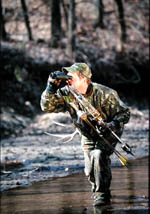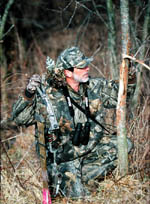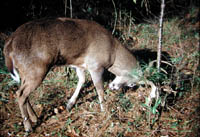
|
Features
|
|
|
|
Books
|
|
|
|
Fun & Games
|
|
|
|
Contact Us
|
|
|
John's Journal... Entry 229, Day 3
BUCKS BY BOAT
Pre-Season Scouting
 Editor's
Note: When you hunt with a boat, you can reach remote areas where other
hunters don't hunt, leave little or no human odor as you go to your stand
site and have a quick, easy and efficient way of getting any buck you
take out of the woods without much dragging. If you decide to hunt using
a boat or a canoe, you drastically can increase your odds for finding
more bucks and for taking bigger bucks each season. You also can enter
the woods silently.
Editor's
Note: When you hunt with a boat, you can reach remote areas where other
hunters don't hunt, leave little or no human odor as you go to your stand
site and have a quick, easy and efficient way of getting any buck you
take out of the woods without much dragging. If you decide to hunt using
a boat or a canoe, you drastically can increase your odds for finding
more bucks and for taking bigger bucks each season. You also can enter
the woods silently.
Scout a waterway-hunting site either just after the hunting season or several weeks before it starts for the most success. But even scouting during the season can pay big-buck dividends for you. Often you'll locate creek crossings and trails on the edge of the water. But, more often than not you'll have to stop occasionally, get out on the bank and look for feeding spots, bedding sites and trails. Generally you'll discover a deer trail within 100 yards of where you leave your boat. Waterways usually have rich soils and an abundance of highly-nutritious natural foods as well as thick-cover areas where the deer can bed and hide. You may want to scout a region for 45 minutes to an hour, climb back in your canoe or johnboat and then move to another area to scout. Each time I find a location with plenty of deer sign that I want to hunt, I'll mark the tree where I want to hang my tree stand as well as the point on the bank where I want to land my boat. Also while I'm going down the waterway, I'll mark shallow-water areas, rapids, trees laying across the creek, boulders out in the creek and any other obstacles that I may encounter.
 When
I complete my scouting, I have my information stored in my hand-held GPS
receiver. I know what I'll encounter along the stream or creek I've decided
to use as transport to my hunting site, have several hunting sites marked
as waypoints and the exact tree identified where I want to put up my tree
stand when I reach that place. I've also usually stuck two Bright Eyes
thumb tacks into the tree so that when I get to my tree stand site before
daylight, I quickly and easily can identify the tree where I've planned
to hang my tree stand. With a hand-held GPS receiver, like my Magellan
SporTrac Pro, I can put a message at each waypoint to tell myself why
I need to hunt each stand site and tell the wind direction I need to hunt
each. Even before the season comes in or goes out, I've got a very detailed
map of how to get to my hunting locations by water. I also know the distance
from each stand site from my put-in point and my take-out point.
When
I complete my scouting, I have my information stored in my hand-held GPS
receiver. I know what I'll encounter along the stream or creek I've decided
to use as transport to my hunting site, have several hunting sites marked
as waypoints and the exact tree identified where I want to put up my tree
stand when I reach that place. I've also usually stuck two Bright Eyes
thumb tacks into the tree so that when I get to my tree stand site before
daylight, I quickly and easily can identify the tree where I've planned
to hang my tree stand. With a hand-held GPS receiver, like my Magellan
SporTrac Pro, I can put a message at each waypoint to tell myself why
I need to hunt each stand site and tell the wind direction I need to hunt
each. Even before the season comes in or goes out, I've got a very detailed
map of how to get to my hunting locations by water. I also know the distance
from each stand site from my put-in point and my take-out point.
 On
some bodies of water with slow-moving, deep water, you may can motor down
to your hunting site and motor back to where you've left your vehicle.
I don't believe that the sound of an outboard motor or a trolling motor
spooks deer like the sound of a 4-wheeler does, especially if you plan
to hunt along a waterway where fisherman regularly use outboard motors.
Although you may find johnboats and motors heavy, the new lightweight
two-man fishing boats that you easily can put in the back of a pickup
truck or on top of the car or a canoe fit water hunting for deer.
On
some bodies of water with slow-moving, deep water, you may can motor down
to your hunting site and motor back to where you've left your vehicle.
I don't believe that the sound of an outboard motor or a trolling motor
spooks deer like the sound of a 4-wheeler does, especially if you plan
to hunt along a waterway where fisherman regularly use outboard motors.
Although you may find johnboats and motors heavy, the new lightweight
two-man fishing boats that you easily can put in the back of a pickup
truck or on top of the car or a canoe fit water hunting for deer.
TOMORROW: CANOEING
Check back each day this week for more about BUCKS BY BOAT ...
Day 1 - Why Bucks Will Be
Where You and Your Boat Are
Day 2 - How to Find Waterways to Hunt
Day 3 - Pre-Season Scouting
Day 4 - Canoeing
Day 5 - The Truism for Taking Big Bucks or
Living a Trophy Life